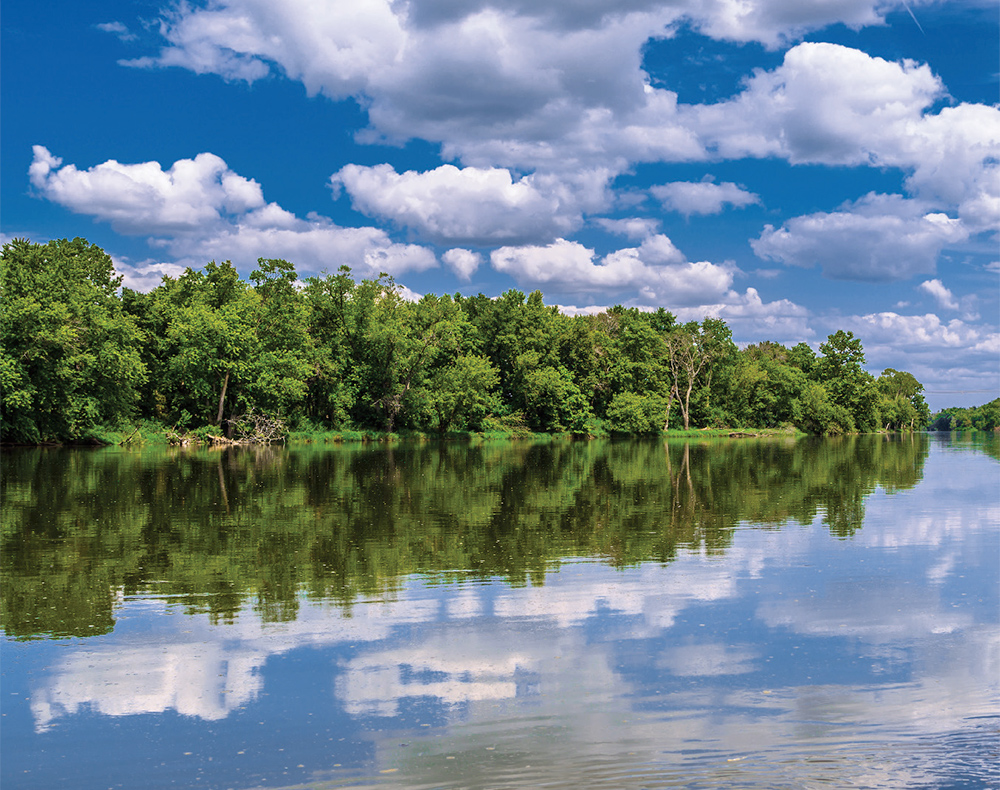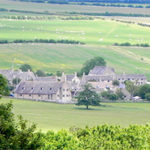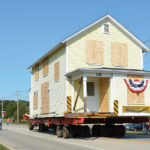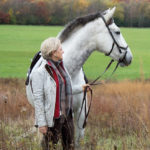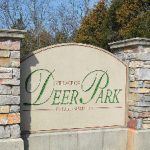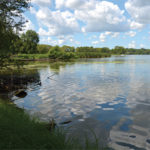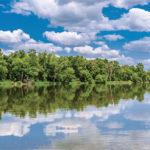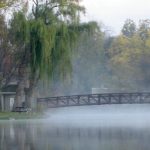Who could have imagined that almost 200 years after the Native Americans forged their trails over the hills and around two shimmering lakes, a village would evolve from that same landscape with winding lanes and hillside cottages reminiscent of the English countryside.
Imagine the view back then from the signal hill, west across the lush countryside to the shining ribbon of the Fox River, the river that had conveyed so many of the native tribes from the south, and from the north, to these rich hunting and gathering grounds. Archaeological evidence from near the Fox River places human habitation in this area 9,000 years ago.
French traders and missionaries in the 17th century recorded the presence of Illiniwek, Mascoutin, and Wes, but from the close of the 17th century until the early 1800s, it was the Potawatomi tribe who dominated this region. A nomadic people, they lived in encampments of portable wigwams. Proud of their skill and bravery as hunters, there was ample sustenance in this bountiful environment of rivers, lakes, streams, and woodlands.
Many of the roads that wind through North Barrington today have layers of history. First trod by Native Americans and wild horses; then the pioneers with their heavy work boots, draft horses, oxen, and wagons, and finally, as one old Barrington commentator called them, those noisy chortling conveyances, the horseless carriages. Miller Road, Old Barrington Road, and Signal Hill Road, from where, according to legend, those arriving along the Fox could see the plumes of smoke drawing them ashore. Biltmore was also a prime encamping area, and where artifacts such as spears, knives, and hatchets were found in the late 19th century.
By the Treaty of Chicago, signed amidst an immense throng in September 1833, the Chippewa, Ottawa, and Potawatomie Indians sold five million acres to the United States and agreed to resettle west of the Mississippi. They gradually slipped away as the first settlers came in from the east. As told in the History of Tower Lakes, published in the January/February 2020 edition of Quintessential Barrington, one of the first permanent settlers in what became Cuba Township, Hugh Davlin, who arrived in 1836, spoke of trading with lingering Potawatomie, who helped him build a root cellar.
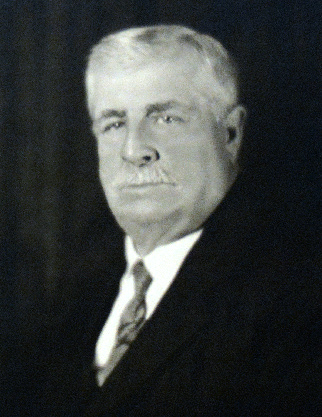
There is an extraordinary letter in area history archives, dated February 4, 1850, written by Gerhard Wessling, who was a relative of noted Barrington businessman John Plagge. It told incoming settlers from Germany what to bring.
Settlers of European Origin
The arrival of the first permanent settlers in 1834 coincided with the Act of the Continental Congress that no lands could be purchased until surveys were completed and registered in the Surveyor General’s office in St. Louis. The settlers or squatters, physically staked their claims with boundaries of fences, stones, or a plow line, while surveyors walked the land with only a magnetic compass and a chain. By 1840, settlers were able to travel to the General Land Office in Chicago and purchase their claims at around $1.25 an acre. Some walked there via Des Plaines.
The earliest settlers came mostly from Massachusetts, New York, and Pennsylvania, and many of those had European origins in Ireland, Switzerland, Norway and Denmark. A decade later they were joined by German families, bringing a frugal and hardworking ethos appreciated by those who had already broken the prairie and begun to understand their new agricultural horizons. There is an extraordinary letter in area history archives, dated February 4, 1850, written by Gerhard Wessling, who was a relative of noted Barrington businessman John Plagge.
Sent to family in Germany, it provides them with complete information they would need for their journey to America. Referring to what they should bring, it tells them to leave behind their books on farming, “for they would not fit in with the type of agriculture carried on here”. Cutting timber to build their log cabins, clearing the prairie, draining wetlands, introducing dairy cows, growing and harvesting grain, being self-sustaining through their own vegetable plots and chickens, and harvesting the bountiful fruits that were a staple of the Native American diet, this was the isolated life that faced those early settlers.
A Township Named Cuba
The decade of the 1850s would change that. In 1850, state law required the organization and naming of townships. The first choice for Township 43 North, Range 9 East of 3rd Principal Meridian, was Troy, that being the area in New York where so many of the first settlers came from. Already taken by a Township in Southern Illinois, according to histories that have survived, it was newly appointed Township Supervisor Lewis Bute, apparently well-informed on national news, who suggested Cuba, where unsuccessfully an attempt was underway to free the island from Spanish rule. Bute’s suggestion was approved by the County Supervisor in Waukegan, the name causing curiosity for newcomers to this day. In 1850, the total valuation of property in Cuba Township was $44,750.
In 1854, as the Illinois and Wisconsin Railroad, shortly to become the Chicago and Northwestern Railway, acquired the 40 acres of Benjamin Felter at the Lake Cook County Line Road, and established the town of Barrington Station, with the line extending on to Fox River Grove and Cary, the entire area became accessible by other than horseback, stage, and mail coaches, and horse-drawn wagons. Families who had previously settled in Deer Grove closer to Palatine, physically moved their houses and stores into the new Village, which gradually became a center of commerce for the surrounding farmers. As dairy farming increased, farmers brought their milk cans to the station for the early morning train to Chicago, and in southwestern Lake County, to a special platform called Cuba Station at the crossing of Kelsey Road. It would be 80 years, before the road designated as Route 59, was extended north through Biltmore to the junction of Kelsey Road, known then as the Wauconda Road.
Dr. E.S. Kimberly
There were routes into Lake Zurich and Wauconda; Miller Road was an established trail early on, and by 1845, the rutted gravel and muddy Rand Road connected the two towns. Large and small parcels circled the two lakes, which appeared on the earliest maps as Honey Lake and Grassy Lake. They were natural lakes, mostly encircled by sloping hillsides.
How a distinguished founder of Chicago and his family found their way out to Honey Lake in 1857, to build a summer residence on its eastern shore is not known. Dr. Edmund S. Kimberly, and his wife, Marie Therese Ellis, arrived on the swampy shores of Lake Michigan from Troy, New York, in 1830. He was one of only five doctors practicing then in the new town. Their names can be found in the “Book of Original Entry” Map of Chicago, located on 39th Street in that year. The signature of E.S. Kimberly appears on the tally sheets voting to incorporate Chicago in 1833, and he was one of the first elected trustees for the town as it was first designated.
Eventually the Kimberly’s owned almost 200 hundred acres along the eastern and southern shores of Honey Lake, and late 19th century photographs recorded a residence of Carpenter Gothic design, its entrance reached along a narrow dirt road facing the lake. Today, it is recognized as 148 Kimberly Road. In the early 20th century the residence was reconfigured with a more classical Colonial design by the well-known architect Robert Work, its entrance turned to face east along the road that bore the family’s name.
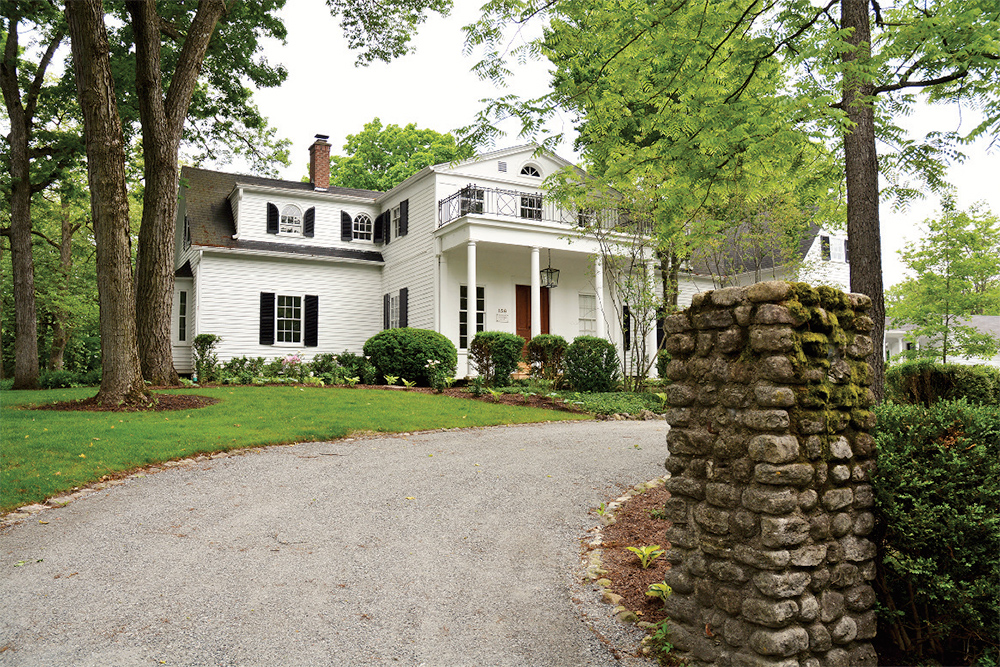
One of the first doctors in the area, E. S. Kimberly, built this home on Kimberly Road near Honey Lake.
A Presidential Connection
The family wrote themselves into local lore, when their eldest son, Augustus Van Horne Kimberly, married Margaret Barnhill Roosevelt, a cousin of the future President, Theodore Roosevelt. The flower urns at the front entrance were a wedding gift from Teddy to his cousin, a fact documented by subsequent owners. The lore was in the story that when Teddy Roosevelt was shot in 1912 at his Bull Moose Party’s convention in Milwaukee, he was brought to the Honey Lake house to recuperate. Extensive research has failed to find any definitive evidence of this, and in fact a special train took him from Milwaukee directly to his home at Sagamore Hill. However, before he became president, Teddy was known to have traveled into the countryside around Chicago.
The Kimberly family left their imprint on Honey Lake well into the 20th century. Their grandson Raymond not only lived in the residence but founded a military academy on the south shore of the lake. This was destroyed by fire in March 1945. Thereafter Raymond re-established the academy in Des Plaines. But after almost 100 years, the road and the residence remained as tangible reminders of this notable family.
Perhaps the presence of the Kimberlys encouraged others to assemble larger land holdings. In 1889, another railroad, the Elgin, Joliet, and Eastern Railway looped from Gary, Indiana, through the collar counties round to Waukegan. As a passenger and freight line that passed through Barrington to Lake Zurich, the areas north between the two towns were more accessible. Miller, Kuhlman, Sinnett, Howarth, and Hickox were some of the pioneer names. William Sandman had assembled almost 500 hundred acres by the end of the 19th century. In addition to being a farmer, Sandman was a banker in Barrington and owned a grain mill on Grove Avenue where the BMO Harris Bank is located.

William Grace’s mansion at Honey Lake in 1907.
William Grace’s Estate
But in 1907, coincidental with the arrival of the first gentlemen farmers in the countryside west of Barrington, a cabinetmaker of English origin with an impressive portfolio of building in Chicago, found his ultimate paradise between Honey and Grassy Lakes. He acquired Sandman’s 500 acres. William Grace had become a prominent contractor in the City of Chicago, with the Cook County Building in the loop, the Rock Island Railroad Station, and City Hall at Clark and LaSalle Streets to his credit, and evidently his wealth. The residence that he built on the highest point along the western shore of Honey Lake was an imposing red brick mansion with an adjacent water tower that dominated the skyline. The use of brick in construction on what was still a farm property was noteworthy against the use of readily available timber at that time. The northern countryside now had its best-known landmark. The Barrington Review reported in the Spring of 1907 that “William Grace was out looking over his summer place”.
William Grace was apparently not without his personal problems. Newspapers reported in 1911 that he had accused a Mrs. Augusta Dahlberg of throwing red pepper in his eyes in attempt to blind him. She was convicted and sent to prison. After her release from prison she brought suit against Grace for “malicious prosecution”, a charge on which he was convicted and ordered to pay Mrs. Dahlberg $22,500 in damages, a considerable sum in those days.
The northern countryside was not only large landowners. Early 20th century Plat Maps clearly delineate the ownership of dozens of smaller parcels on which families farmed for a living, or with the availability of rail and motor transportation, worked in nearby towns. There were several well-attended country schools, which were sold at Consolidation in 1947 and became residences. Note them today: The White School at Old Barrington and Cuba Roads with its restored belfry; Flint Creek at Miller and Kelsey Roads; Kelsey School on Route 22 west of the hospital, its grounds now productively re-used for the Smart Farm; the Davlin School north of the Tower Lakes Village Hall on Route 59; the Honeycutt or Honey Lake School on Honey Lake Road, was originally located near Rainbow Road and Route 22, and the Bennett School, part of a residence on the north side of Miller Road at Route 12. All were consolidated into the ultra modern North Barrington Elementary School, heralded as “a school for the motor age” with a specially designed entrance to allow bus and car arrivals.
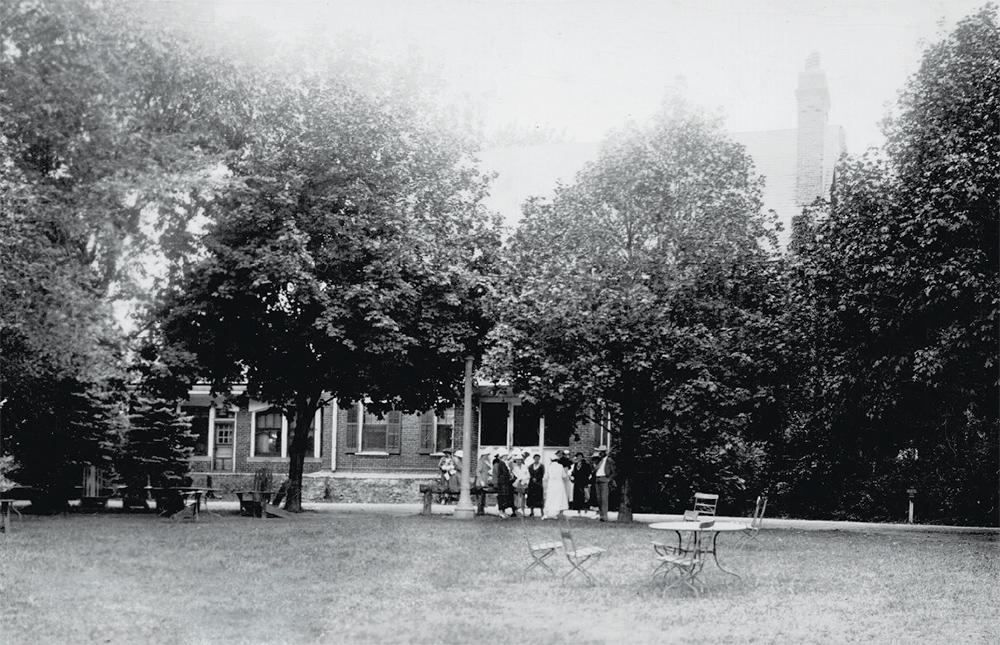
A gathering at the posh new Biltmore Country Club in the mid-to-late 1920s.
Clifford Leonard Creates Biltmore
One of the most important benchmarks in the evolution of the north countryside came in 1925. While there was a land boom around the Village of Barrington for city buyers acquiring country properties for estates and gentlemen farms, a businessman, Clifford Leonard, president of Leonard Construction Company and a director of the First National Bank of Chicago, purchased the William Grace Estate, the Leonard and Clark farms for a total of 804 acres. Leonard’s vision was different. He wanted a countryside weekend retreat for city dwellers that they could buy into.
The original plan for the property that he named Biltmore was for 2,300 small lots, a clubhouse, 18-hole golf course, stable, polo field, tennis courts, toboggan and ski jump, and an airfield. All but the polo and airfields would eventually be developed, but there was a toboggan and ski run north of Honey Lake Road. A syndicate was formed by the developer to put in the roads and developments, and many early residents of Biltmore invested from $1,000 to $15,000 to develop the property.
The former Grace Mansion became the home of Biltmore Country Club and the golf course was completed in 1926. Bruce Bell built the first house in 1927. He was of the Bell Family of apple orchard fame, and John Bell, the landscape designer of Jewel Park in Barrington. Lot purchasers automatically became club members, most of them then residing in Chicago. Just as the Kimberlys had done all those years ago, weekends at Honey Lake were relaxing and fun filled, although it was minimum two-and-a-half-hour drive from the city. Rand Road, now Route 12, had been paved in 1925. Biltmore was reached either by Miller Road or Signal Hill Road. The extension of Route 59 north to Wauconda occurred in 1935.
The Great Depression Impact
The Great Depression era saw Biltmore’s membership drop from around 600 to less than 100, but importantly it was always a social cornerstone for the northern community. Even so, by the late 1930s, the Chicago Sunday Tribune was headlining the greater Barrington District as the site of a “back to land” movement among “agricultural minded urbanites”. Describing the attraction of the countryside, the report stated, “during the last four years that rolling, wooded and lake dotted terrain has attracted city dwellers from Chicago and nearby towns to purchase approximately 14,000 acres. Among prominent northern countryside buyers was Henry G. Zander, President of the Chicago Real Board and head of the National Association of Real Estate Boards; Sheldon Clarke, President of Sinclair Oil and Commodore of the Chicago Yacht Club; Emil Wetten, an Attorney and a former candidate for mayor of Chicago; Ernest Byfield, famed restaurateur and hotel owner.
North Barrington Celebrity Friends
Byfield’s residence, now Grassmere Farms, at the southeast corner of Routes 22 and 59, enjoyed a heyday as the country retreat for the owner of the Sherman and Ambassador West and East Hotels. In 1938, in the latter, Byfield opened the famous Pump Room. In those days, cross-country travel between the East and West Coasts, was mostly by train, with a stopover in Chicago. Celebrities vied to be hosted by Byfield in the Pump Room’s Booth Number One and interviewed by Chicago’s foremost columnist, Irv Kupcinet. On a longer visit they might be invited out to Barrington. Byfield offered them a fun-filled weekend especially when it came to cocktail time. Two buildings visible today at the east side of the main house were a pool house and a “mad house”. Guests were summoned to cocktails when a fire siren wailed across the countryside. This was the signal for them to swim across the pool from the pool house to the mad house, where they slid down a brass fire pole to the bar and dance floor. Other activities included horseback riding at Eugene Byfeild’s equestrian property on the north side of Route 22. When this was bisected by the northward extension of Route 59 in 1935, a tunnel was built under the road to allow humans and animals access to both sides of the property.
In 1950, Grassmere Farms was acquired by the John D. MacArthur Foundation and the residence was used by Paul and Estina Doolin, who as associates of MacArthur would maintain an active social life, with well-known members of MacArthur’s family and their friends among frequent visitors to the estate. They included the playwright Charles MacArthur and his wife, the actress Helen Hayes.
In those years too, there was a famed equestrian presence when M.B. (Mike) Mervis, President of the Mercon Copper and Steel Products Company, acquired much of the Kimberly property south of Honey Lake. There he founded The Oaks Farm for his stable of prized Arabian horses. He was Secretary Treasurer of the Midwest Arabian Horse Owners Association, and amassed one of the largest collections of carved wooden horses and carriages in the world which were exhibited at the Smithsonian Institution.
After the Second World War, there was an outward movement to suburban and semi-rural areas, with business and industry fuelling expansion into the collar counties. Home builders and buyers sought large tracts of undeveloped land for high density subdivision. The Barrington area became more accessible when the Northwest Tollway was opened by 1957. North of Route 22, the Biltmore summer cottages were being adapted as year-round residences, and larger properties were being subdivided into one and two-acre parcels. This was raising alarm bells for many local residents.
The Fight to Remain Rural
At this time, the principal governmental and land use jurisdiction outside of incorporated towns was vested in Lake County in Waukegan. There was little local input if a developer went before the Zoning Board with a high-density proposal. Ironically, Clifford Leonard’s Biltmore Country Estates, intended only as summer residences would never receive approval today, although the plat did include many larger parcels.
Fortunately for the Barrington area, there have always been individuals and organizations that have recognized the rich natural environments outside the Village of Barrington and have functioned as watchdogs where local government oversight was lacking. Founded in 1934, the North Barrington Association of Cuba Township provided just such oversight. From its inception, the group had advocated for the interests of property owners in the largely unincorporated township. By the late 1950s, they initiated a fight to reform the zoning ordinances governing Cuba Township and to protect its semi-rural environment from over development.
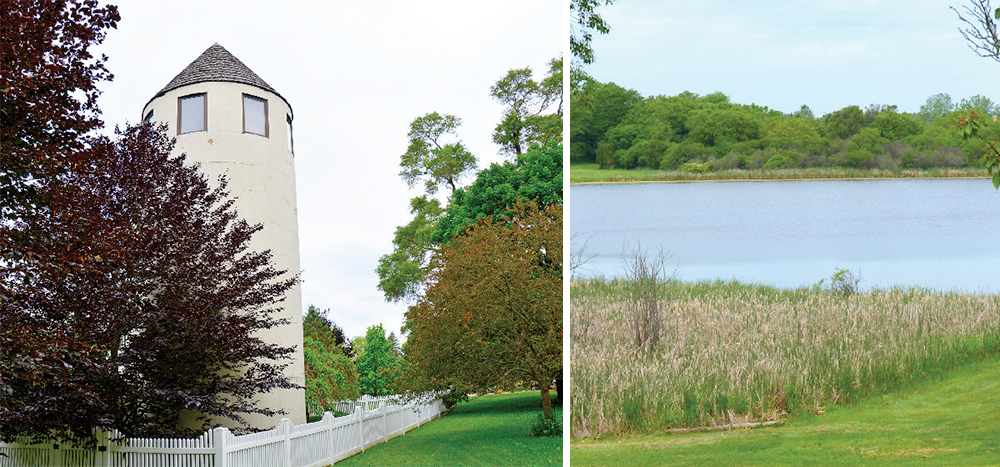
Left: This silo was original to a home on Signal Hill Road that is no longer. In the garage of the home, with a vote of 108 to 28, the annexation to form North Barrington was passed in 1959. Right: Grassy Lake is a 41.4-acre natural glacier-formed lake.
Protecting Rural Spaces
At the time, the association’s president was Kenneth C. Hunter, head of the Chicago real estate firm Hunter and Harwell, and its secretary was Nelson Forrest of Biltmore, executive director of the North Michigan Avenue Association. He was later a North Barrington Trustee and Village President. He was to be active in North Barrington affairs for over 40 years. Together with Cuba Township Supervisor Joseph P. Welch, they hired Everett Kincaid and Associates to draft a new land use plan for the area. The plan sought to guide the character of future development to preserve the existing semi-rural character and open spaces in the township. It called for upgraded zoning from farm and small lot residential zoning, to Lots of 1,2, and 5 acres. With lakes, streams, and wetlands, adequate space was required for individual septic systems and private wells. Outside of the Village of Barrington there was no feasible connection to these facilities.
A petition for land reclassification was filed with Lake County in 1957 and considered by the County Zoning Board of Appeals in a series of lengthy hearings at Barrington High School. While the North Barrington Association was said to enjoy the support of 90% of the property owners, and backing from the Biltmore Homeowners Association, there were some vocal objectors to the Plan. The first hearing on December 5, 1957, lasted over 3 ½ hours and was attended by over 350 residents, an exceptional turnout given the township population at that time.
After a long drawn out process, the County Zoning Board sent an unfavorable recommendation to the County Board. That the County Board did approve the Plan was credited to the tenaciousness of the North Barrington Association. There were a number of residents who continued as members of the association until it was disbanded in 2003. But even with the newly approved County zoning ordinances in 1958, there was still concern among the residents of the Biltmore area, both east and west of Route 59, that a unit of local government was necessary to protect the quality of the environment and give those residents a stronger voice in day-to-day decisions on the ground.
By joint action of the North Barrington Association and the Biltmore Homeowners Association, petitions were circulated to call for a special election on the question of incorporation as a village. Seventy-four property owners endorsed the petition and an election was held on October 31, 1959. In an unconscious salute to history, that election was held in the garage of the Douglas T. Krumlinde farmhouse at 615 Signal Hill Road, close to that high point from which the smoke signals had been sent out in pre-settlement times. The farmhouse had been originally built by pioneer Wesley Hickox. A silo remains on the property today.
On that day, with a vote of 108 to 28, the vote to approve annexation passed and the Village of North Barrington was born. The first election to select a village president, clerk and trustees took place at the Krumlinde residence on November 21, 1959. C. Richard Anderson was elected the first Village President. The first board of trustees included Nelson Forrest, J.A. Battilo, Walter W. Hutchison, Arthur E. Urick, Vincent Bliss, and Douglas T. Krumlinde. Like several of the newer Barrington area villages, the first and early meetings were held in a residence. In North Barrington it was the home of the Village Clerk, Grayce Scharfenberg at 114 Mohawk Drive. Roads off of Signal Hill Road commemorated the area’s early history when they were designated as Mohawk, Onondaga, Ottawa, Osage, Seminole, and Sioux.
The original village boundaries encompassed less than 2-square miles with about 200 residents. The west Biltmore area around Grassy Lake, and those Biltmore properties east of Route 59 and bounded by Golfview and Woodland drives. After several hearings, and a narrow margin of votes, the eastern portion of Biltmore was annexed into the village on May 20, 1961.
Since then, in keeping with the original ideals of the North Barrington Association, the Village of North Barrington has expanded its boundaries directly south and north of Route 22, and eventually east to include the Wynstone Golf Course community, in order to preserve, through zoning, a countryside character offering gracious residential communities where woods and lakes and pastures are the back drop for family living, and residents are involved in the stewardship of this priceless heritage.
This is a story of the past. Village President Eleanor Sweet McDonnell will take the story forward.
A Note from the Author:
Barbara L. Benson, May 29, 2020
The erstwhile North Barrington Association was later renamed as The Greater North Barrington Area Association that it would not be confused as a unit of North Barrington government. I was president of the Association from 1995 until it was disbanded in 2003. I was privileged to know some of those founders of the Village of North Barrington: Nelson Forrest, Richard Anderson, and early residents Norma and Leslie Behrend. They were dedicated, principled people who valued the gifts of the natural environment and sought to live in harmony with them. They were our countryside warriors.
Over many years, I have researched much about the Village of North Barrington. Preparing to write this article I went to the village website. I was surprised to see my name noted as a contributor to the comprehensive village history which was posted there to coincide with the 50th Anniversary of the village’s incorporation. This narrative is drawn from that history, with additional notes. Readers are
encouraged to visit the website.
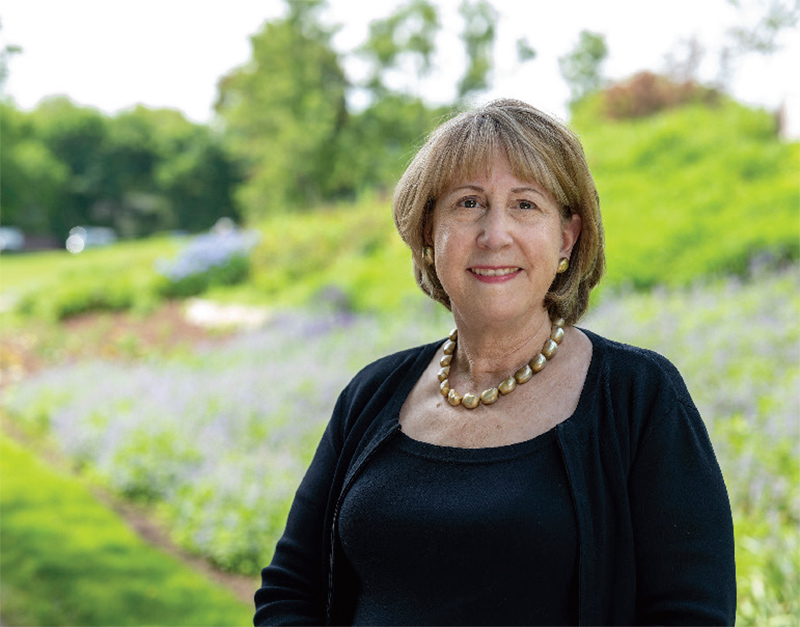
North Barrington
A Letter from the Village President
By Eleanor Sweet McDonnell
North Barrington is literally a “hidden gem”, found off the beaten path of the bustle and hustle of the day-to-day hectic life all around us. Conveniently located off major highways Route 12, Route 22, or Route 59, you enter a community with incredible overhead canopies from lovely mature oak trees. Suddenly everything is less hectic and calming as you drive alongside one of our streams, ponds, or lakes and enjoy our magnificent trees. In some parts of our Village a visitor will drive narrow quaint roads from the Indian paths or horse and buggy days, now paved.
The original roots of the North Barrington community is steeped in a history that strongly embraces a rustic, rural countryside environment that is blessed with an abundance of natural flora, fauna, creeks (Flint Creek), ponds (Duck Pond), lakes. (Honey Lake, Grassy Lake) and Grassy Lake Forest Preserve, just to name a few. The Village has created protected areas with Haverton Conservation Area (17.5 acres) and our own Wildlife Refuge (5.9 acres).
Our founding fathers carried a passion for a semi-rural, countryside environment, while fiercely protecting the open spaces, low density, and championing anti-development. This same spirit is still prevalent in the Village of North Barrington today.
North Barrington was one of the original founding BACOG members 50 years ago, a local organization that embraced those same values. The Village of North Barrington was incorporated in 1959.
The Village of North Barrington offers an interesting combination of privacy for our residents, while at the same time is a warm, inviting village with a strong sense of being an intimate community.
The Village has an eclectic collection of homes ranging from original rustic cabins, hunting lodges, Craftsman style summer cottages, farmhouses, heritage homes from the 1800s, ranch style, estate homes, and new construction. Several of our homes have been designed by well-known Chicago architects such as William Cooley, Dennis Blair, and Frank Wright Lloyd students from the Frank Lloyd Wright School of Architecture.
Moving to North Barrington
I moved to North Barrington from New England, specifically Maine. When I found this current house in Biltmore, it reminded me of the ocean inlets in Maine. There are a fair number of residents in North Barrington who have lived in New England at one time and have been drawn to the area due to the similar topography. My current home was built in 1910; the original hunting lodge before Biltmore Estates was established in 1926. My first home in North Barrington was an 1875 farmhouse surrounded by Clement Stone’s property on three sides prior to Wynstone. I am a city/country girl who spent 50% of my life on a 50-acre farm in Ohio.
I knew that I wanted my future children to know, appreciate, and learn to love nature the way I did. I felt it was a safe place to raise kids with all the wonderful natural resources surrounding us. I was pleased that it offered the Barrington 220 School District, a national Blue-Ribbon School District. North Barrington residents are lucky with having the option of two great award-winning school districts with Barrington 220 and Lake Zurich 95. For our children they were lucky to have the benefit of the North Elementary School being so close to home.
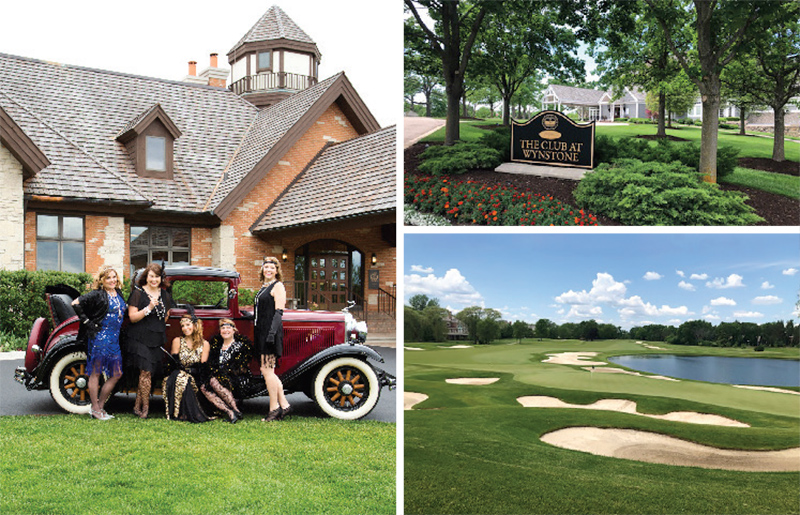
Left: Quintessential Barrington covered Biltmore Country Club’s 90th anniversary celebration in 2016. Photo: April Graves. Right: Wynstone Golf Club in North Barrington. Photo: Greg Rogus.
Communities in the Village
North Barrington gives residents easy access to theater, culture, and shopping while being able to retreat to their homes. The Village has a great collections of unique mini communities with Biltmore Estates, Oaksbury, Brook Forest, Grassmere Farms, Haverton on the Pond, Christopher Pines, Pennington Pond, Timbercreek, Arboretum, and Wynstone, and most recently Old Barrington Farms to name a few.
The Village of North Barrington is in the unique position of being the only municipality in the area that has two country clubs with Biltmore County Club and Wynstone within its boundaries, in addition to Old Barrington Farm, a 60-acre premier equestrian farm which resides in the Village of North Barrington.
North Barrington has four great outdoor parks (over 33 acres) for the residents with Eton, South Eton, Lenoard, and Lafferty Park. These parks offer walking and hiking trails in addition to a playground, baseball diamond, and soccer fields.
The Village offers three outdoor concerts during the summer at Eton Park. This is like our very own local mini Ravinia, where everyone brings their chairs and picnics to enjoy the outdoor concerts. This is a great family event for children, neighbors, and friends. Our signature event is our 25-year annual Fall Fest held at Eton Park, with live music, a petting zoo, hayride through the area, crafts, pumpkin painting, and great community spirit while everyone catches up with all their neighbors.
Grassy Lake Forest Preserve is located within the northwest corner of North Barrington boundaries and part of Lake Barrington. North Barrington residents have access to 5.78 miles of trails and 682 acres of beautiful land.
During our Arbor/Earth Day event we honor the day with trees and nature information. In addition, we announce and introduce the “Tree of the Year Award”. This is an annual award given to the resident, since 2015 whose tree has been nominated that year due to the trees size, beauty, and overall visual impact. This year North Barrington is proud to have been named a “Tree City USA” for the 20th consecutive year. The Tree City USA is sponsored by the Arbor Day Foundation, USDA Forest Service, and National Associations of State Foresters.
I just found out that the Village of North Barrington was awarded by Niche.com this year, 2020, the #13th Best Place to Raise a Family in Lake County, and #16th Best Place to Live in Lake County. I guess the secret is out, of what a great place North Barrington is!
A Need for Leadership
Prior to being sworn into office, residents told me that they were concerned that our Village was operating as a “hobby”. After being sworn in, I dug into the financial documents of the Village. It was obvious to me that the Village needed a major update and upgrade in terms of creating more professional, effective operational systems, processes, and an alignment with today’s common municipal practice in terms of better financial management of our funds.
In the last year we have focused on bringing conservative spending back to the Village of North Barrington. This involved a yearlong effort lead by me with input from the Board of Trustees, a new Treasurer, and new Village Administrator. My goal for the first year in office was to reverse the previous budget pattern, where the expenditures were exceeding the revenue. Our new budget finally brings the Village expenditures into alignment with our revenue for the first time in years. The Village has a much stronger and promising financial future.
Within minutes of being sworn in I enacted the “Village of North Barrington Guiding Principles”. I wanted to make sure going forward that the Village was fully transparent with the residents of what their expectations should be from the Village, Board, Commission, and staff. Going forward we continue to improve our communication to the residents embracing Facebook, Instagram, quarterly physical newsletter, and Village updates through regular email blasts.
We were in the midst of a rebranding marketing campaign and new website for Village residents. Due to COVID-19 that was put on hold. We plan to reactivate this project once COVID-19 has settled down.
The Village of North Barrington has a Board of Trustees that is committed to the community and the residents. We have created a strong collaborated working atmosphere with the Village, Board, and Commissions that works very well for our community.
“The lifestyle we enjoy in North Barrington is unique. Few other suburban areas have been able to retain the natural beauty, and open space we are able to enjoy in our community. The countryside atmosphere we experience today is possible only because of the forethought and careful planning of those who came before us. One of the highest priorities of the Village leadership is to preserve and enhance unique qualities and integrity that have defined North Barrington as a natural environment and residential community since its beginnings 50 years ago.” – Barbara L. Benson
I could not have said this better. The Village of North Barrington is committed to supporting our forebears mission of protecting our natural resources including water, flora, and fauna, and our tranquil open spaces.
The Village of North Barrington has pivoted toward a stronger future going forward. I feel blessed to have a such strong team with our staff, Board, Commissions (and members), and Treasurer. We have great residents and we are all honored to serve them.
About Village President McDonnell
Eleanor Sweet McDonnell was elected Village President in 2019, her first term. For 14 years she served as Lake Zurich Rural Fire Dept., Trustee, North Barrington; North Barrington Fire Commissioner; and North Barrington Plan Commission member. She has lived in North Barrington for 36 years. She and Peter, her husband, have a daughter (BHS 2015), and son who will be a Junior at BHS this fall. She graduated from Boston College with a BS in Marketing, and Kellogg Graduate School of Management where she received her MM(MBA). She is President/CEO of The Remington Group, a consulting firm specializing in improving organizational performance and business revenue.
– End –
Share this Story

